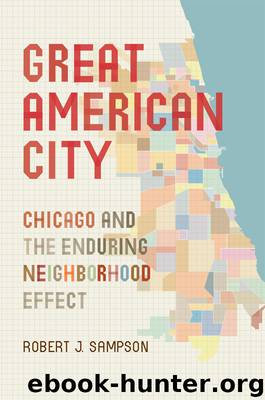Great American City by Sampson Robert J

Author:Sampson, Robert J.
Language: eng
Format: epub
Publisher: University of Chicago Press
Published: 2012-11-17T05:00:00+00:00
12 Individual Selection as a Social Process
In late 2008 the Chicago Tribune ran a special series on what they called “Separate Chicagos.” Belying the illusory image of harmonious integration beaming from Grant Park on the election-night triumph of Barack Obama, the Tribune described Chicago as “America’s Most Segregated Big City.”1 The series portrayed in vivid terms how racial lines drawn years ago remain entrenched and reinforced by people’s choices.
What seems to be a simple point—that choice matters—is in fact complex and the subject of much controversy among social scientists. One side takes the view that segregation and constraints of inequality override choice, in extreme cases almost as if individuals are pawns in a predetermined game. Another side valorizes choice to the point where it is said to undercut research efforts to investigate the effects of neighborhood context. Individuals “escape” poverty, for example, by differentially allocating themselves nonrandomly according to their ability and preferences. Observational estimates of neighborhood effects on outcomes such as crime, mortality, teenage childbearing, employment, low birth weight, mental health, and children’s cognitive ability are, by this logic, confounded and thereby biased. The MTO debate in the previous chapter is the prime case in point of the alleged “curse” of neighborhood selection bias.2
The typical response of quantitatively oriented scholars to individual selection is to view it as a statistical problem to be controlled away and not something of substantive interest in itself. For this reason selection pathways are more imagined than they are examined. The most common approach in the literature has been to estimate the effect of a “structural” factor like concentrated poverty on an individual outcome after controlling selected individual-level variables. The other approach, exhibited in the case of MTO, is to conduct a randomized experiment.
As I argued in chapter 11, however, selection is much more than a statistical nuisance when we consider its implications for inequality in neighborhood attainment and broader population or city-level processes. To extend this point, in this chapter I elaborate an alternative view that simultaneously invokes the power of structure and choice— “chains of selection,” as it were. I argue that the sorting of individuals by place is not just a technical concern for those studying neighborhood effects, it is a process that knits together and defines the social-ecological structure of the city. This argument is consistent with what the economist James Heckman calls the “Scientific Model of Causality,” in which the goal is to confront directly and achieve a basic understanding of the social processes that select individuals into causal “treatments” of interest.3 As we saw with MTO, experimental randomization does not tell us about how causal mechanisms are constituted in a social world defined by the interplay of structure and purposeful choice by individuals. Although rare in the literature, studying the predictors of sorting and selection into neighborhoods of varying types is therefore an essential ingredient in the larger theoretical project of understanding neighborhood effects.
Building on and extending collaborative work with Patrick Sharkey, this chapter focuses on a key
Download
This site does not store any files on its server. We only index and link to content provided by other sites. Please contact the content providers to delete copyright contents if any and email us, we'll remove relevant links or contents immediately.
| Africa | Americas |
| Arctic & Antarctica | Asia |
| Australia & Oceania | Europe |
| Middle East | Russia |
| United States | World |
| Ancient Civilizations | Military |
| Historical Study & Educational Resources |
Cat's cradle by Kurt Vonnegut(15115)
Pimp by Iceberg Slim(14237)
4 3 2 1: A Novel by Paul Auster(12235)
Underground: A Human History of the Worlds Beneath Our Feet by Will Hunt(11986)
The Radium Girls by Kate Moore(11877)
Wiseguy by Nicholas Pileggi(5618)
Perfect Rhythm by Jae(5283)
American History Stories, Volume III (Yesterday's Classics) by Pratt Mara L(5218)
The Fire Next Time by James Baldwin(5207)
Paper Towns by Green John(5032)
Pale Blue Dot by Carl Sagan(4867)
A Higher Loyalty: Truth, Lies, and Leadership by James Comey(4803)
The Mayflower and the Pilgrims' New World by Nathaniel Philbrick(4385)
The Doomsday Machine by Daniel Ellsberg(4380)
Killers of the Flower Moon: The Osage Murders and the Birth of the FBI by David Grann(4355)
The Sympathizer by Viet Thanh Nguyen(4269)
Too Much and Not the Mood by Durga Chew-Bose(4237)
The Borden Murders by Sarah Miller(4197)
Sticky Fingers by Joe Hagan(4071)
